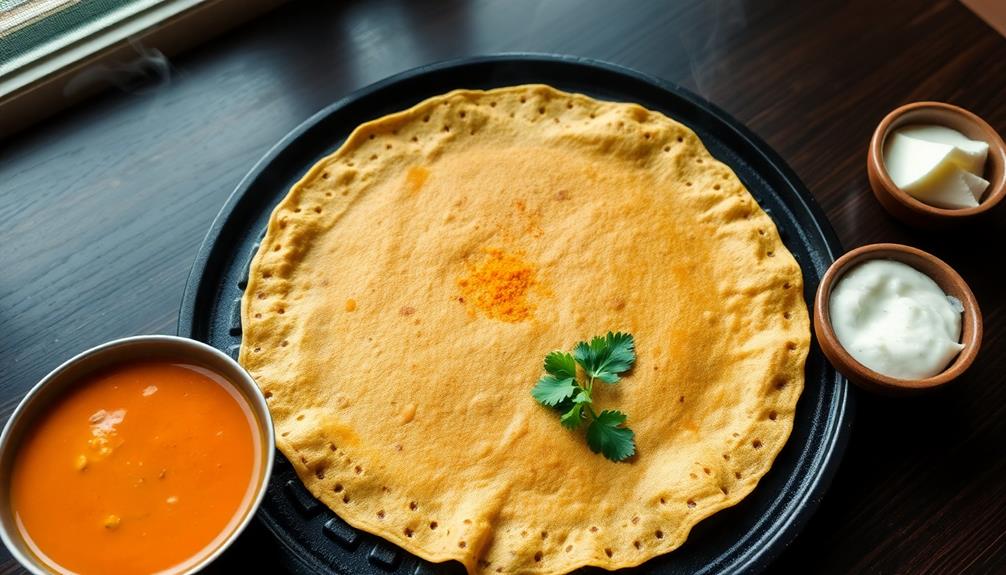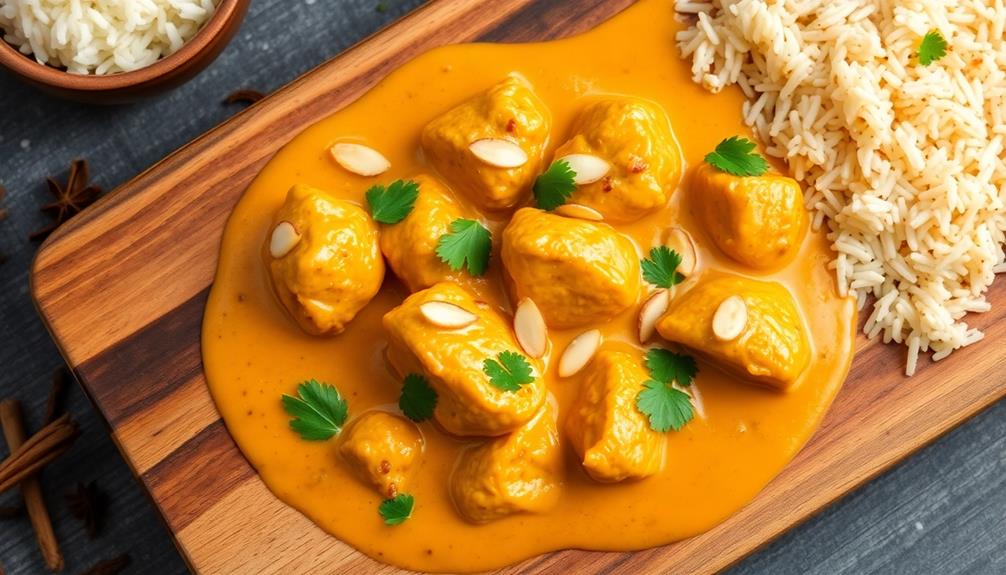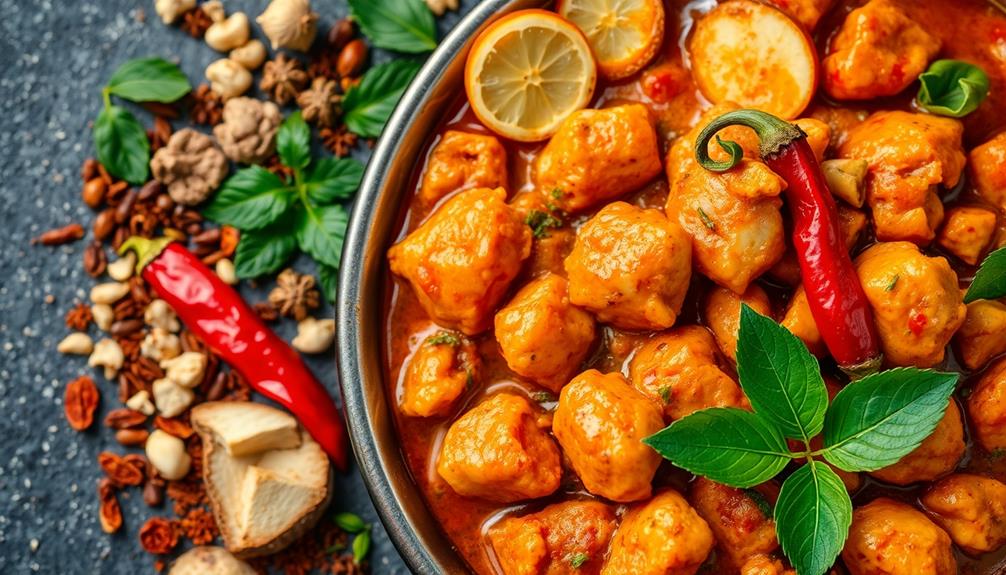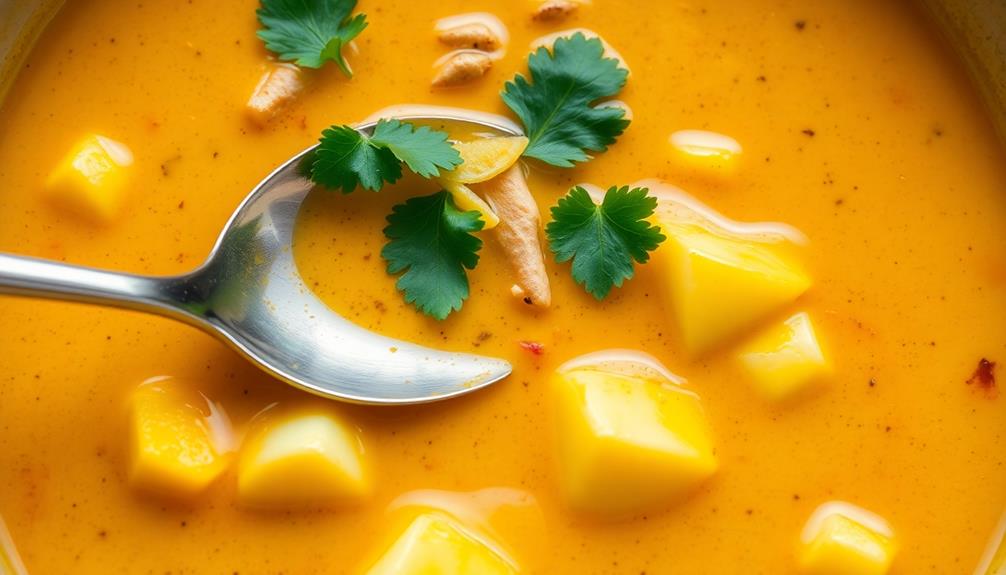Gulab jamun is a beloved Indian dessert that's been enchanting taste buds for centuries! This spongy, syrupy treat originated in the Mughal royal kitchens, and today it's a cherished part of Indian culture. The key is the perfect blend of milk solids, flour, and semolina – when fried to a golden brown and soaked in a fragrant rose-scented syrup, the result is pure indulgence. With its contrasting textures and harmonious flavors, it's no wonder gulab jamun is a staple at celebrations and festivals. Want to learn more about this timeless delight and how to make it yourself?
Key Takeaways
- Gulab Jamun is a popular Indian dessert that originated in the 16th century Mughal kitchens, made from khoya or paneer and deep-fried into spongy, syrupy balls.
- The recipe has evolved over time, with variations using milk powder or paneer, and it remains a cherished part of Indian cuisine, often served at celebrations and festivals.
- The cooking process involves kneading the dough, rolling it into balls, deep-frying, and soaking the fried balls in a sugar syrup, resulting in a delightful combination of textures and flavors.
- Gulab Jamun is known for its soft, spongy interior and sweet, aromatic syrup, and it represents hospitality and warmth in Indian culture, evoking nostalgia for the bustling streets of India.
- Gulab Jamun can be served warm or chilled, and it is often garnished with chopped pistachios, rose petals, or cardamom for added flavor and visual appeal.
History
Gulab jamun's origins can be traced back to the 16th century, when it was first prepared in the royal kitchens of the Mughal Empire. This beloved Indian dessert has a rich history that's intertwined with the opulent courts of the Mughals, similar to the way unique culinary experiences are celebrated today.
Back then, these delectable dumplings were made from a mixture of khoya (reduced milk solids) and flour, then deep-fried and soaked in a fragrant rose-scented syrup. Over the centuries, the recipe has evolved, with variations using milk powder or paneer (fresh cheese) instead of khoya.
Today, gulab jamun remains a cherished part of Indian cuisine, served at celebrations, festivals, and special occasions. Whether you enjoy them warm or at room temperature, the irresistible combination of spongy, syrupy goodness is sure to delight your taste buds. If you’re looking to add a modern twist to this classic dessert, consider pairing gulab jamun with a refreshing Stgermain spritz recipe. The floral notes of the Stgermain liqueur complement the sweetness of the gulab jamun, creating a delightful contrast of flavors. Whether enjoyed on its own or as part of a creative dessert pairing, gulab jamun continues to be a beloved treat in Indian cuisine.
Indulge in the rich history and timeless flavors of this iconic Indian dessert.
Recipe
Gulab Jamun is a beloved and delectable Indian dessert that has captivated the hearts and taste buds of many around the world. This decadent treat, made from milk solids kneaded into a dough, then shaped and deep-fried to perfection, is a true delight for the senses.
The joy of discovering new flavors and culinary traditions is akin to the thrill of exploration, where each bite offers a taste of the passion for discovery. The origins of Gulab Jamun can be traced back to the royal kitchens of the Indian subcontinent, where skilled chefs perfected the art of creating this indulgent confection.
It's a testament to the rich culinary heritage of the region and the ingenuity of its people.
Ingredients:
- 1 cup milk solids (khoya or paneer)
- 1/2 cup all-purpose flour
- 1 tablespoon semolina (suji)
- 1/4 teaspoon baking soda
- 2 tablespoons sugar
- 1/2 cup warm milk
- Oil for deep-frying
- Syrup:
- 1 cup water
- 1 cup sugar
- 1/2 teaspoon rose water (optional)
Cooking Instructions:
In a mixing bowl, combine the milk solids, all-purpose flour, semolina, baking soda, and sugar. Gradually add the warm milk and knead to form a smooth, pliable dough. Cover the dough and let it rest for 30 minutes.
Divide the dough into lemon-sized balls and gently roll them between your palms to shape them. Heat oil in a deep-frying pan or wok and carefully drop the dough balls into the hot oil. Fry the Gulab Jamun until they turn golden brown, then drain them on a paper towel-lined plate.
For the syrup, in a saucepan, combine the water and sugar. Bring the mixture to a boil, stirring occasionally, until the sugar dissolves completely. Remove from heat and stir in the rose water (if using).
Add the fried Gulab Jamun to the warm syrup and let them soak for at least 30 minutes, turning them occasionally, to allow the flavors to meld and the Gulab Jamun to absorb the syrup.
Serve the delectable Gulab Jamun warm or chilled, and enjoy the burst of sweetness in every bite.
Cooking Steps
Knead the dough until it's nice and smooth – you want it to be just right. A well-prepared dough can make a significant difference in the final texture of your gulab jamun, much like how understanding the mechanics of different brewing methods affects your coffee experience.
Then, roll the dough into small, even balls. Next, carefully fry those balls until they're golden brown.
Step 1. Knead the Dough Thoroughly
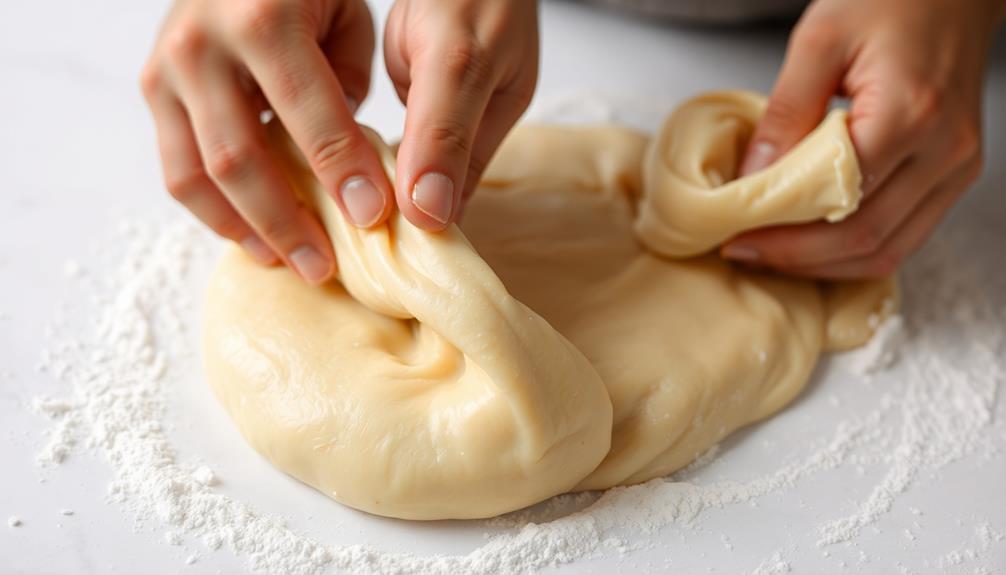
After mixing the ingredients together, it's crucial to knead the dough thoroughly. This step helps develop the gluten, which gives the gulab jamun its signature chewy texture.
It's important to manage your kitchen budget effectively while cooking, as tracking expenses can help you enjoy delicious treats without overspending budgeting essentials. Don't be shy – get in there with both hands and really work the dough. Knead it for about 5-7 minutes, pressing, folding, and turning the dough until it becomes smooth and elastic. You'll know it's ready when the dough springs back when you poke it.
Be sure to knead on a clean, lightly floured surface to prevent sticking. If the dough feels too dry, add a teaspoon of milk at a time until it reaches the right consistency. On the other hand, if it's too sticky, sprinkle in a bit more flour.
The goal is a soft, pliable dough that's easy to shape. Thorough kneading is key for achieving the perfect gulab jamun texture, so don't skimp on this step. Get ready to roll up your sleeves and get to work!
Step 2. Roll Dough Into Small Balls
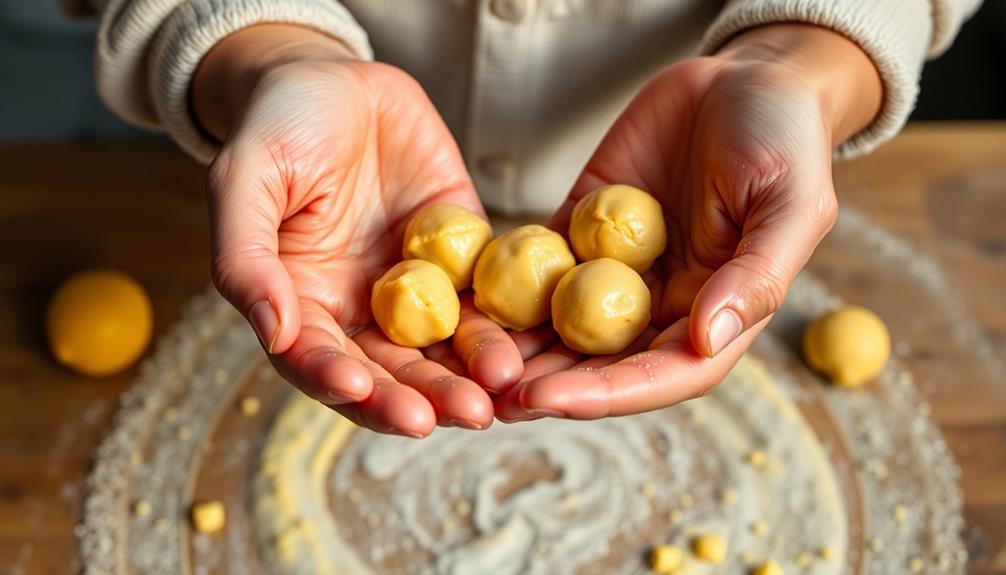
Once the dough has been thoroughly kneaded, you'll want to roll it into small, even balls. This is an important step in creating the perfect gulab jamun.
Chia seeds, known for their high nutritional value and versatility, can inspire creativity in your cooking process. Start by taking a small piece of the dough, about the size of a walnut, and gently roll it between your palms.
Roll it back and forth until it forms a smooth, round ball. The key is to use a light touch and avoid overworking the dough. As you roll, apply just enough pressure to shape the ball without compacting the dough too much.
Aim for balls that are roughly the same size so they'll cook evenly. Once you've rolled all the dough into balls, place them on a clean surface and get ready for the next step.
With a little practice, you'll be rolling out perfect gulab jamun balls in no time!
Step 3. Fry the Dough Balls
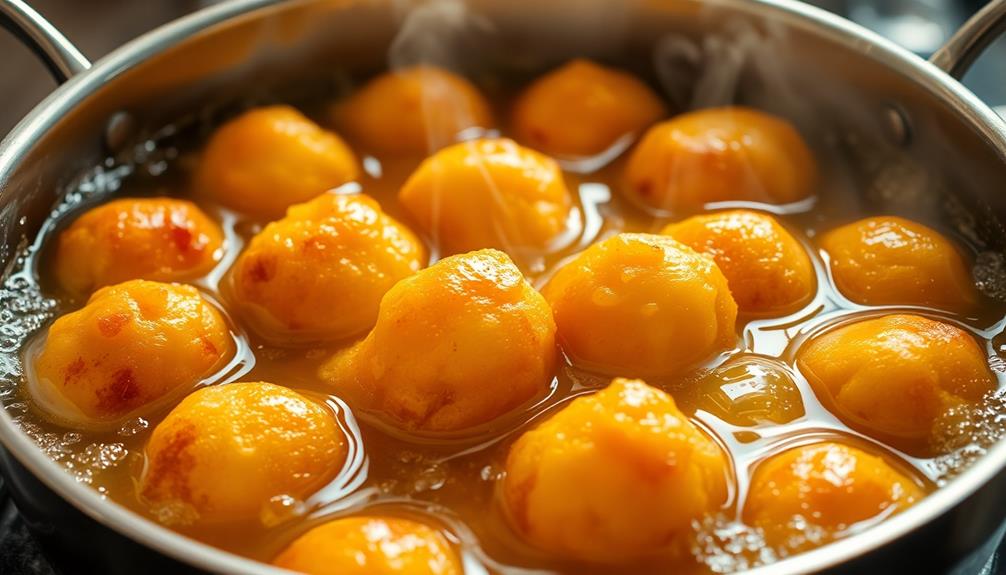
With your perfectly formed dough balls ready, you can now move on to frying them. Grab a heavy-bottomed pan and pour in enough oil to comfortably submerge the dough balls. Heat the oil over medium-high heat until it's shimmering and ready for frying.
For a delightful twist, consider serving your gulab jamun alongside a creamy pasta dish like roasted red pepper rose pasta, which complements the sweetness beautifully.
Gently drop the dough balls into the hot oil, being careful not to overcrowd the pan. Fry them for a few minutes, turning them occasionally, until they're a beautiful golden-brown all over. The outside should be crispy and the inside soft and delicious.
Once the dough balls are perfectly fried, use a slotted spoon to transfer them to a plate lined with paper towels. This will help absorb any excess oil.
Let them cool slightly before serving, as the insides will still be hot. Now you can enjoy your freshly fried gulab jamun, savoring the sweet and indulgent flavors in every bite.
Step 4. Soak Balls in Sugar Syrup
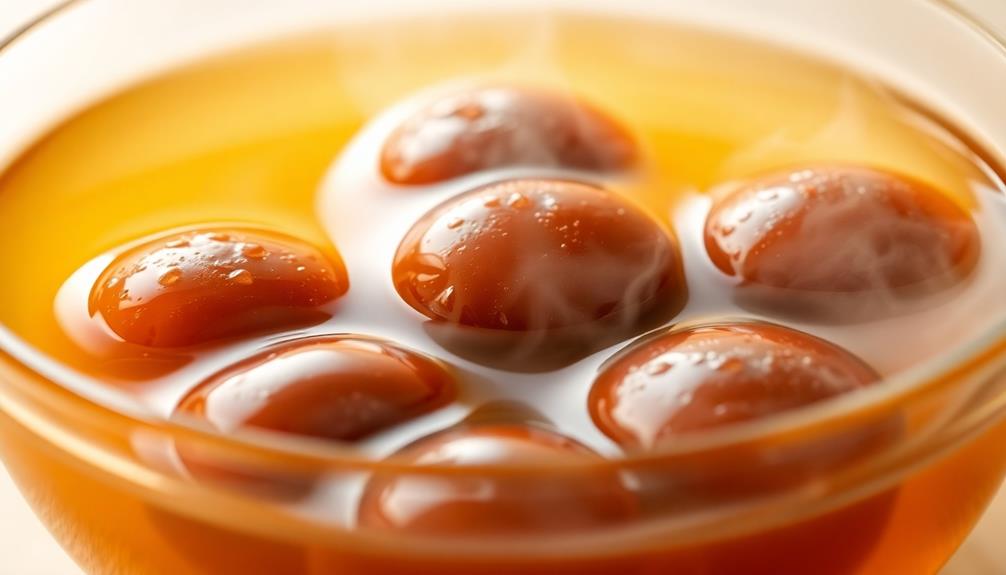
Next, you'll want to soak the fried dough balls in a sweet sugar syrup. This is a crucial step that brings the gulab jamun to life!
In a saucepan, combine water, sugar, and a few cardamom pods. Bring this mixture to a boil, then reduce the heat and let it simmer for about 10 minutes. The sugar will dissolve, creating a rich, fragrant syrup.
Gently add the fried dough balls to the syrup. Let them soak for 30 minutes, turning occasionally, until they've plumped up and absorbed the sweet flavor. The balls should be glossy and a deeper shade of brown when ready.
Carefully remove them from the syrup using a slotted spoon, letting any excess drip back into the pan.
Arrange the soaked gulab jamun on a serving plate. Garnish with a sprinkle of chopped pistachios or a light dusting of rose petals, if desired.
For an extra decadent touch, drizzle a spoonful of warm saffron-infused syrup over the gulab jamun just before serving. This traditional Indian dessert is the perfect ending to any meal, especially when paired with a refreshing glass of lassi. Looking for more delicious recipes to try? Check out our chicken jalfrezi recipe for a flavorful and satisfying dinner option.
Serve warm or at room temperature, and enjoy the delightful combination of soft, spongy dough and aromatic sugar syrup!
Step 5. Serve Warm and Garnished
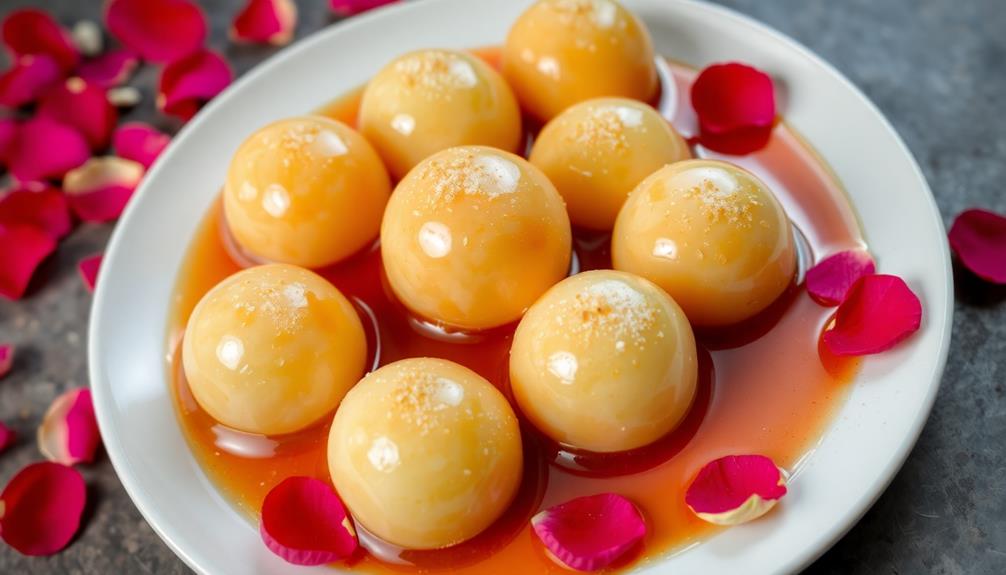
Arrange the soaked gulab jamun on a serving plate. The warm, golden-brown orbs should be glistening with the sweet syrup. Carefully place them in an appealing pattern, allowing their smooth, round shapes to shine.
To elevate the presentation, consider pairing them with a fermented vegetable plate for a delightful contrast of flavors and textures. Sprinkle a light dusting of ground cardamom over the top, adding a fragrant touch. If you'd like, you can also garnish the plate with a few fresh mint leaves or slivered pistachios for a pop of color and crunch.
Now, it's time to serve these delectable treats. Grab a spoon and scoop up a gulab jamun, ensuring you get a bit of the syrup as well. Savor the explosion of flavors – the soft, spongy interior contrasting with the outer crust, all enveloped in the sweet, aromatic syrup.
Encourage your guests to dig in and enjoy the warm, comforting goodness of these traditional Indian sweets. The combination of textures and the harmony of spices will delight the senses and leave everyone craving more.
Final Thoughts
A delightful finish to any meal, Gulab Jamun is a true indulgence. Whether enjoyed as a special treat or a comforting dessert, this classic Indian sweet is sure to delight your taste buds. The combination of soft, spongy dumplings soaked in a fragrant rose-scented syrup is simply divine.
Additionally, the use of natural ingredients in desserts like these can complement a balanced diet, similar to how juice diets require careful planning to avoid deficiencies.
As you savor each bite, you'll be transported to the bustling streets of India, where the aroma of freshly fried Gulab Jamun fills the air. Ensure to serve these delectable morsels warm, allowing the syrup to soak in and the flavors to meld together perfectly.
Garnish with a sprinkle of chopped pistachios or a delicate rose petal for an extra touch of elegance.
Gulab Jamun is a timeless delight that can be enjoyed year-round, whether as a special occasion dessert or a comforting treat on a cozy evening. Indulge in the rich, indulgent flavors and create lasting memories with every spoonful.
Frequently Asked Questions
How Long Does Gulab Jamun Last Once Prepared?
Freshly prepared, it'll stay fresh for 3-4 days when stored in the fridge. But beware – the texture and flavor start deteriorating after a day or two. So it's best enjoyed soon after making.
Is Gulab Jamun Vegan or Gluten-Free?
Gulab jamun is not typically vegan or gluten-free. It contains dairy products like milk and ghee, and its main ingredient is khoya, which is made from reduced milk. To enjoy a vegan or gluten-free version, you'd need to find a specialized recipe.
Can Gulab Jamun Be Frozen for Later Use?
Yes, you can freeze gulab jamun for later use. Simply place the cooked dumplings in an airtight container or freezer bag and store them in the freezer for up to 3 months. When ready to serve, thaw and reheat.
What Is the Best Way to Store Leftover Gulab Jamun?
The best way to store leftover gulab jamun is to keep them in an airtight container in the refrigerator. This will help them stay fresh for up to a week, so you can enjoy them later.
Can Gulab Jamun Be Made in Advance Before an Event?
Yes, you can make gulab jamun in advance before an event. Store them in an airtight container in the refrigerator, and they'll stay fresh for up to 5 days. Just reheat them before serving for the best texture and flavor.



